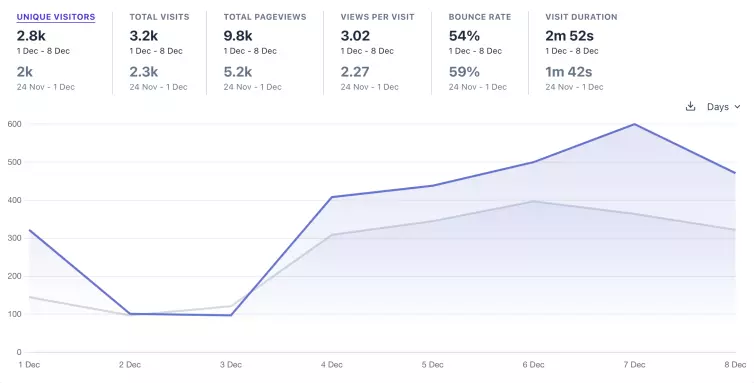Driving Digital Growth with Smart Content Planning


The content on your website speaks volumes about your business. It's not just about having an online presence; it's about making that presence count. Whether you're contemplating the website development cost for a new project or looking for a website plan template to streamline your existing content, effective planning is key.
Embarking on planning a website goes beyond just aesthetics. It involves thoughtful consideration of your audience, your brand message, and how to deliver it most effectively. A well-thought-out website plan ensures that every page, every piece of content aligns with your business goals.
We'll explore how a comprehensive website planning process can simplify this task, helping you to efficiently plan website design and content. From choosing the right website planner template to utilising website planning tools, our focus is to provide you with practical tips to create a site plan that resonates with your audience and enhances your online visibility.
Whether you're a seasoned professional or new to web planning, this guide offers valuable insights into website project planning and website design planning. Let's navigate the exciting journey of creating a website that not only looks great but also delivers exceptional user experience and results.
Understanding Your Audience

The success of your website planning hinges on one crucial factor: knowing your audience. It's the foundation upon which all other elements rest. Whether you're planning a website for a corporate entity or a small business, understanding who you're talking to is essential.
Identifying Your Audience: Begin by defining who your website is for. Look into demographics, interests, and online behaviours. This step is vital in ensuring your website plan resonates with the right people.
Tailoring Content to Audience Needs: Once you know who your audience is, tailor your content to meet their needs and interests. This is where your website content planning plays a crucial role. It's not just about what you want to say, but also about what your audience wants to hear.
Using Analytics for Insight: Utilise website analytics tools to gain deeper insights into your audience's preferences and behaviour. This data can inform your ongoing website planning, helping you to refine your strategy and content.
Engaging and Interacting: Don’t just broadcast content; engage with your audience. Use your website and social media platforms to create a two-way conversation. This engagement can provide valuable feedback for future web planning and content creation.
Adapting and Evolving: Your audience’s needs and preferences may change over time, and your website plan should be flexible enough to adapt. Regularly review and adjust your approach to stay relevant and engaging.
Understanding your audience is not a one-time task but an ongoing process that should be at the heart of your website planning strategy. By taking the time to truly understand and connect with your audience, you'll be able to create a more effective and impactful online presence.
Setting Clear Goals and Objectives

A critical step in website planning is establishing clear, achievable goals and objectives. This clarity directs your efforts and helps measure success.
Defining SMART Goals: Your website plan should start with Specific, Measurable, Achievable, Relevant, and Time-bound (SMART) goals. Whether it's increasing traffic, enhancing user engagement, or driving sales, each goal should align with your overall business strategy.
Aligning Goals with Business Objectives: Every element of your website project planning should support your broader business objectives. This alignment ensures that your website contributes effectively to your business's growth and success.
Creating a Roadmap for Success: With goals in place, develop a roadmap for achieving them. This might include specific milestones, such as launching new features, publishing a certain number of blog posts, or reaching specific SEO rankings. This roadmap is a vital part of your website planning tool kit.
Flexibility in Planning: While having a clear website design plan is essential, flexibility is key. The digital landscape is ever-changing, so be prepared to adapt your plan in response to new trends, audience needs, and business goals.
Regular Review and Adjustment: Regularly review your goals and the effectiveness of your website planning. Use data and analytics to inform decisions and make necessary adjustments to your web plan.
By setting clear and measurable goals, your website planning becomes more focused and effective. This not only ensures that your website meets its intended objectives but also contributes to the overall success of your business.
Creating a Content Calendar

An essential tool in website content planning is a content calendar. It's not just a schedule; it's a strategic plan that ensures your content aligns with your goals and reaches your audience at the right time.
What is a Content Calendar?: A content calendar is a roadmap for your content strategy. It details when and what you'll publish, aligning with your website plan and marketing objectives.
Benefits of a Content Calendar: This tool brings organisation and focus to your website planning. It helps avoid last-minute rushes, ensures a consistent content flow, and aligns your posts with key business events or dates.
Steps to Create Your Calendar: Start by choosing a format (digital, spreadsheet, or website planning tool) that works best for you. Plot out important dates first, like product launches or seasonal events. Then, fill in with regular content, such as blog posts or social media updates.
Incorporating Variety in Content: A good website planner template for your calendar should include a mix of content types – articles, videos, infographics, etc. This variety keeps your audience engaged and caters to different preferences.
Using Tools and Resources: There are many website planning tools available to help manage your calendar. These tools can assist in scheduling posts, collaborating with team members, and analysing content performance.
Adapting Your Calendar: Remember, while a content calendar is a great web planning tool, it should be flexible. Be ready to adjust your calendar in response to audience feedback, trending topics, or business changes.
A well-structured content calendar is a backbone of effective website content planning. It ensures that your content is not only well-planned but also aligns with your overall website project planning goals, making your digital strategy more coherent and impactful.
Developing Content Themes and Topics

The heart of any successful website plan lies in its content. Developing engaging themes and topics is crucial for captivating your audience and achieving your website's objectives. Here’s how to approach this vital aspect of website content planning.
Brainstorming Content Themes: Start by brainstorming themes that align with your brand identity and audience interests. Consider what sets your business apart and how you can reflect this uniqueness in your content. This approach should be a foundational element of your website planning process.
Utilising Keyword Research: To ensure your content resonates with your audience and ranks well in search engines, incorporate keyword research into your web planning. Identify the terms and phrases your audience is searching for and weave these into your content themes.
Balancing Evergreen and Trending Topics: In your website plan, include a mix of evergreen content that remains relevant over time and trending topics that capture immediate interest. This balance keeps your content fresh and engaging, ensuring a steady flow of traffic to your site.
Creating a Topic Repository: Develop a repository of potential topics based on your themes. This can be part of your website planning tool arsenal, ensuring you never run out of ideas. Regularly update this list to keep it current and relevant.
Aligning Topics with Business Goals: Each topic you choose should have a purpose and align with your overall business goals. Whether it's driving traffic, generating leads, or educating your audience, ensure that your topics contribute to these objectives.
Seeking Audience Input: Engage with your audience to understand what content they find valuable. You can use surveys, social media polls, or comments to gather this information, which can then inform your ongoing website content planning.
Regular Review and Update: The digital world is ever-evolving, and so should your content themes and topics. Regularly review your content strategy to ensure it remains relevant and impactful.
By carefully developing your content themes and topics, you create a strong foundation for your website's content planning. This not only enhances the user experience but also strengthens your website's authority and relevance in your niche.
Writing and Designing Engaging Content

Creating compelling content is at the core of a successful website plan. It's not just about what you say, but how you say it and how it's presented. Let’s delve into the art of writing and designing content that captivates and engages your audience.
Crafting Compelling Copy: The key to effective content is clarity, conciseness, and relevance. Your writing should speak directly to your audience, addressing their needs and interests. Use a tone that resonates with your readers and reflects your brand personality. This approach is a vital part of website content planning.
Incorporating Storytelling: Everyone loves a good story. Use storytelling to make your content more engaging. This technique helps to humanise your brand and makes complex information more relatable.
Utilising Visuals: A crucial aspect of website design planning is incorporating visuals. Images, videos, infographics, and charts can break up text, illustrate points, and keep the reader engaged. Ensure that your visuals are high quality and relevant to the accompanying content.
Ensuring Consistency in Design: Consistency in your website’s design helps build brand recognition. This includes using a consistent colour scheme, typography, and layout style across all pages. Consistency should be a key consideration in your web plan.
Optimising for Readability: Make your content easy to read and navigate. Use headings, subheadings, bullet points, and short paragraphs to enhance readability. This is an important aspect of web planning, ensuring that users stay engaged and can easily find the information they need.
Creating Interactive Elements: Interactive elements like quizzes, polls, and clickable infographics can increase user engagement. They provide a dynamic experience, making your website more interactive and enjoyable.
SEO Best Practices: While writing and designing content, keep SEO in mind. Use keywords naturally, optimise meta descriptions, and ensure your content is accessible. This is a crucial part of website planning to improve visibility and reach.
Testing and Refining: Use A/B testing and feedback to refine your content. What works for one audience may not work for another, so be open to making changes based on user interaction and engagement data.
Writing and designing engaging content is a continuous journey of learning what resonates with your audience. By focusing on these elements, you can ensure that your content not only attracts attention but also encourages interaction, making your website planning efforts more effective and rewarding.
Content Promotion and Distribution

Having great content is just half the battle; the other half is making sure it reaches your audience. Effective content promotion and distribution are crucial elements of your website plan. Let’s explore how to get your content seen by a wider audience.
Leveraging Social Media: Social media platforms are powerful tools for promoting content. Share your posts on channels where your audience is most active. Tailor your message for each platform to maximise engagement. This approach is an integral part of modern website planning.
Email Marketing: Utilise email newsletters to share your latest content with subscribers. A well-crafted email can drive traffic back to your website and increase reader engagement. Regular, informative emails can be a cornerstone of your website content planning strategy.
Collaborations and Guest Posting: Collaborate with other businesses or influencers in your industry to reach new audiences. Guest posting on reputable websites can also boost your visibility and establish your authority.
SEO Optimisation: Ensure your content is optimised for search engines. This increases the likelihood of your content being found organically. SEO should be a key component of your website planning tools and strategy.
Paid Advertising: Consider using paid advertising for significant posts or promotions. Platforms like Google Ads or social media advertising can be effective in amplifying your reach.
Content Syndication: Syndicating your content on platforms like Medium or LinkedIn can help you reach a wider audience. Just be sure to follow best practices to avoid SEO penalties.
Using Analytics for Insight: Track the performance of your content across different channels using analytics tools. This data will help you understand where your promotion efforts are most effective and should be an ongoing part of your web planning.
Regular Updates and Repurposing: Keep your content fresh and consider repurposing old content in new ways. This can give a new life to your existing content and is an important aspect of efficient website content planning.
By implementing these strategies, you can ensure that your valuable content doesn’t just sit on your website but reaches and engages your target audience, making your website planning efforts more fruitful.
Measuring and Analysing Content Performance
 Plausible Analytics screenshot.
Plausible Analytics screenshot.
To ensure the success of your website plan, it's critical to measure and analyse the performance of your content. Understanding what works and what doesn't enables you to refine your strategy and make more informed decisions in your website content planning.
Setting Up Key Performance Indicators (KPIs): Identify KPIs that align with your website goals. These might include page views, time spent on page, bounce rate, and conversion rates. Clear KPIs are the cornerstone of effective website project planning.
Analytics Tools: Use web analytics tools like Plausible Analytics or Google Search Console to track and analyse your content's performance. These tools provide valuable insights into how users interact with your content, which is essential for effective web planning.
Evaluating Content Engagement: Look beyond basic metrics like page views. Analyse engagement signals such as comments, shares, and average time on page. This helps in understanding the impact of your content on your audience, a vital part of website planning.
Content ROI Analysis: Assess the return on investment (ROI) of your content, especially if you have incurred costs in content creation or promotion. This analysis helps in determining the cost-effectiveness of your website content planning strategies.
Heatmaps and User Behaviour: Tools like heatmaps can provide visual insights into how users interact with your pages, indicating areas of high engagement or areas that are being ignored. This can inform changes to both content and layout in your website design planning.
A/B Testing: Experiment with different versions of a page or post to see what performs best. A/B testing can reveal powerful insights into user preferences and behaviour, guiding your website planning tools and strategies.
Feedback and Surveys: Direct feedback from users through surveys or feedback forms can provide qualitative insights into your content’s effectiveness and areas for improvement.
Regular Review and Adaptation: Make it a habit to regularly review your content's performance. Use the insights gained to adapt and refine your web plan, ensuring that your content remains relevant and impactful.
By rigorously measuring and analysing your content's performance, you can continually enhance the effectiveness of your website planning efforts, ensuring that your content not only reaches but also resonates with your intended audience.
Regular Content Updates and Maintenance

Regular content updates and maintenance are key aspects of your website plan that contribute significantly to your site's relevance, engagement, and SEO performance.
Scheduling Regular Content Reviews: Incorporate a schedule for reviewing and updating content into your website content planning. This could be monthly, quarterly, or bi-annually, depending on your resources and the nature of your content.
Updating for Accuracy and Relevance: Regularly check your content for outdated information, broken links, and obsolete statistics. Keeping content accurate and relevant is essential for maintaining trust with your audience and is a critical aspect of website planning.
Refreshing Old Content: Revisit old blog posts or pages to see if they can be updated with new information, images, or links. Refreshing content can give it a new lease of life and improve its performance in search engine results, an important element of website project planning.
Optimising for SEO: As search engine algorithms evolve, so should your content. Regular updates provide opportunities to enhance SEO, incorporating new keywords, and improving meta-descriptions and titles in line with your web planning strategies.
Leveraging Analytics for Improvement: Use analytics data to identify content that is underperforming. Analysing this data should be a routine part of your website planning tools usage, guiding you on what content needs revamping.
Encouraging Repeat Visits: By regularly updating your content, you give your audience a reason to come back. This not only improves traffic but also reinforces your brand's value proposition.
Planning for Scalability: As your website grows, ensure your content strategy is scalable. This might involve automating parts of the website content planning process or investing in content management systems.
Maintaining a Consistent Voice and Style: Even as you update content, it’s important to maintain a consistent brand voice and style. This consistency should be a part of your website design planning, ensuring a cohesive user experience.
Regular updates and maintenance of your website’s content signal to both your audience and search engines that your site is active and relevant. This ongoing process is an integral part of your website planning, crucial for long-term success and engagement.
Conclusion
As we wrap up this comprehensive guide on website content planning, it’s clear that crafting a successful website is an ongoing process, not a one-time effort. Each step, from understanding your audience to regularly updating your content, plays a vital role in the overall success of your website plan.
Remember, the digital landscape is constantly evolving, and so should your website. By staying committed to regular reviews and updates, leveraging the right website planning tools, and staying in tune with your audience's needs, you'll not only maintain but also enhance your online presence.
The journey of website planning and content creation is both challenging and rewarding. It requires dedication, creativity, and a willingness to adapt. But the results – a website that not only looks great but also effectively communicates with and engages your audience – are well worth the effort.
We hope this guide has provided you with valuable insights and actionable strategies to take your website content planning to the next level. Whether you’re just starting out or looking to refine your existing website plan, the key is to keep learning, experimenting, and growing.
Here's to creating a website that not only meets but exceeds your and your audience's expectations. Happy website planning!
Turn Plans into Reality: Kickstart Your Website Project Now
Now that you’re armed with the knowledge and strategies for effective website content planning, it’s time to put these insights into action. Whether you’re starting a new website plan from scratch or refining your existing content strategy, the path to a successful online presence lies ahead.
Start Planning Today: Don’t wait for the perfect moment. Use the tools and tips from this guide to begin shaping your website project planning now. Every step you take brings you closer to a more engaging and successful website.
Share Your Progress: As you embark on your website planning journey, we’d love to hear about your progress and successes. Share your stories and experiences with us on twitter.com/d3creativeuk.
Seek Professional Assistance: If you find yourself needing more personalised guidance, I'm here to help. Book a free consultation for bespoke website planning tools and consultancy services that can take your website to the next level.
Your journey to a stellar online presence is just beginning. Embrace the process of website content planning with enthusiasm and creativity, and watch as your digital footprint grows. Let’s build something amazing together!

Meet your website specialist
Stephen Meehan is an experienced web designer and developer who creates customer-focused websites that drive results for businesses across the UK and beyond.
More posts about website planning
- How to Differentiate Your Website from Competitors
- Key Questions to Discuss With Your Web Developer
- Redesigning Your Website: A Guide to Enhancing Your Online Presence
- Mastering the Art of Website Planning for a Flawless Redesign
- Unleash Your Website's True Potential: Unlock the Power of Website Audits
- Achieving Website Success: An 8-Step Guide to Planning
- 9 Proven Strategies to Zero-In on Your Website's Target Audience
